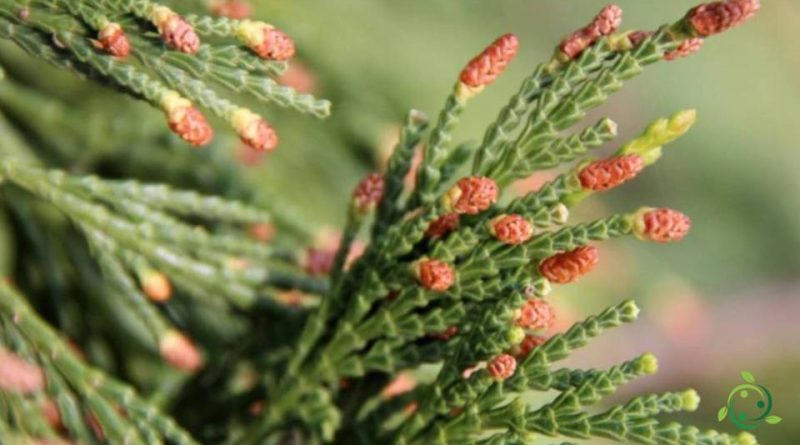Reproduction of the Incense cedar
Reproduction of the Incense cedar
The Incense cedar or California incense-cedar (Calocedrus decurrens (Torrey) Florin 1956) is a conifer native to western North America where it forms mountain woods in association with the Lawson cypress, Douglas fir, sequoias and various broad-leaved trees. In Europe it was introduced in the mid-nineteenth century for ornamental purposes.
Suitable breeding habitat –
The Incense cedar is a plant that grows in an area corresponding to western North America and which is centered in the Sierra Nevada, California, and extends from west-central Oregon in the north to the northern part of the Mexican state of Baja California to South; it touches the western regions of Nevada to the east.
In these areas it grows at altitudes between 50 and 2900 m a.s.l.
The plant was subsequently introduced in Europe starting from 1850 for ornamental purposes and in Italy it is present in parks belonging to period villas, such as in the province of Lucca, at Villa Grabau, contexts of celebratory planting or urban furniture. and private land.
Propagation –
Calocedrus decurrens is a conifer that naturally grows up to almost 3,000 meters in the south.
The plant tolerates hot and dry summers, but also winter frost and snow, remaining vital with temperatures that drop to -34 ° C in the north of its range.
It is a rather tolerant plant to various types of soil, with a wide range of pH values from strongly acidic to about neutral but needs generally well-drained soil. However, it is rarely found on limestone. It is a plant that grows in the sun and tolerates shade when young.
It grows best in a location sheltered from strong winds.
The trees are slow-growing but long-lived in nature, with specimens up to 1,000 years old.
Propagation occurs by seed with sowing in early spring in an unheated greenhouse.
When the seedlings have reached the size that they can handle they should be planted in individual pots and grown in light shade in a cold greenhouse for their first winter.
The transplant should be done in late spring or early summer, after the last frosts expected and it is advisable to protect young plants from the cold for their first winter outdoors.
It can also reproduce by cutting with young wood, taken in mid-autumn, and rooted in a light sandy soil in a protected but not heated environment.
Ecology –
Calocedrus decurrens lives in an area characterized by dry summers, generally with monthly rainfall of less than 25 mm; the extreme annual temperatures are between -34 ° C and 48 ° C. Annual rainfall, partly snowy, ranges from 380 to 2030 mm, with the driest conditions found near the northern limits of the species in Oregon and northeastern California. It grows on an exceptionally wide variety of soils, derived from silicate, serpentine and carbonate parent materials, and of consistency ranging from coarse sand to clay.
It is a plant rarely found in pure populations, it is usually a subdominant or co-dominant component present in mixed woods which, in the northern part of its range, are in intercropping with: Chamaecyparis lawoniana, Thuja plicata, Abies concolor var. lowiana, Abies grandis, Pinus jeffreyi, Pinus lambertiana, Pinus monticola, Pinus ponderosa, Pseudotsuga menziesii subsp. menziesii, Tsuga heterophylla, Quercus garryana, Quercus kelloggii, Lithocarpus densiflorus, Castanopsis chrysophylla and Arbutus menziesii. In the central part it grows with Sequoiadendron giganteum, Abies concolor var. lowiana, Abies magnifica, Pinus contorta subsp. murrayana, Pinus jeffreyi, Pinus lambertiana, Pinus ponderosa, Pseudotsuga menziesii subsp. menziesii, Quercus kelloggii, Lithocarpus densiflorus, Castanopsis chrysophylla and Arbutus menziesii. In the southern part, it grows with Pinus coulteri, Pinus jeffreyi, Pinus ponderosa, Pinus lambertiana, Pseudotsuga macrocarpa and Quercus kelloggii. Associated trees on ultramafic soils (igneous rocks with very low silica content, less than 45%) include Pinus attenuata, Pinus jeffreyi, Pinus lambertiana, Pinus monticola and Pseudotsuga menziesii subsp. menziesii (Powers and Oliver 1990).
Calocedrus decurrens tolerates moderate fire due to its thick bark.
It is a tree that is widely cultivated as an ornamental. In ancient times it was also an important wood species, much preferred for the manufacture of the pencil due to its softness and isotropy. Although lumber yields have been reduced by the depletion of old growth woods, its wood, exceptionally resistant to rotting and highly durable when exposed to the elements, is still useful for woodworking applications including cedar chests and cabinets.

